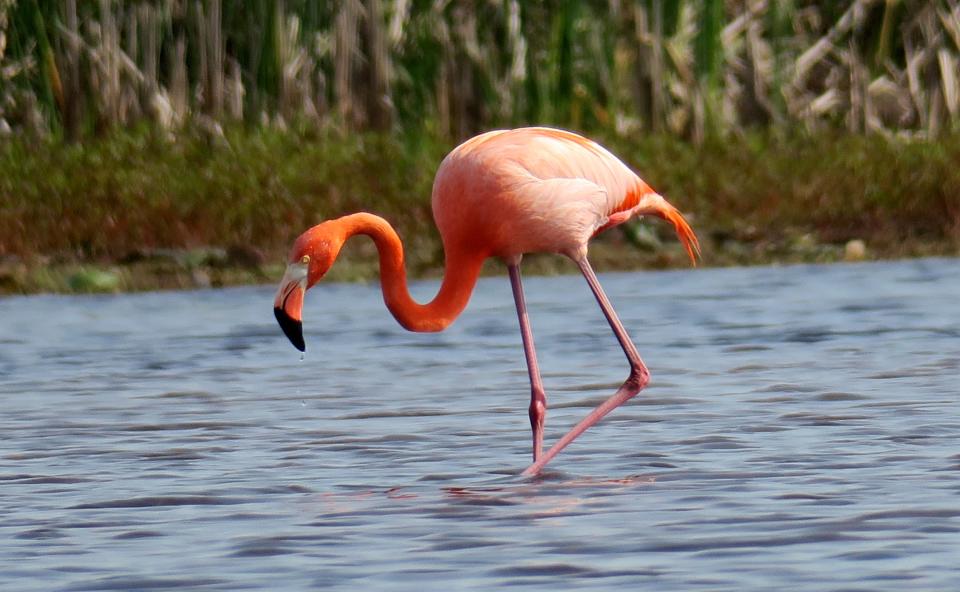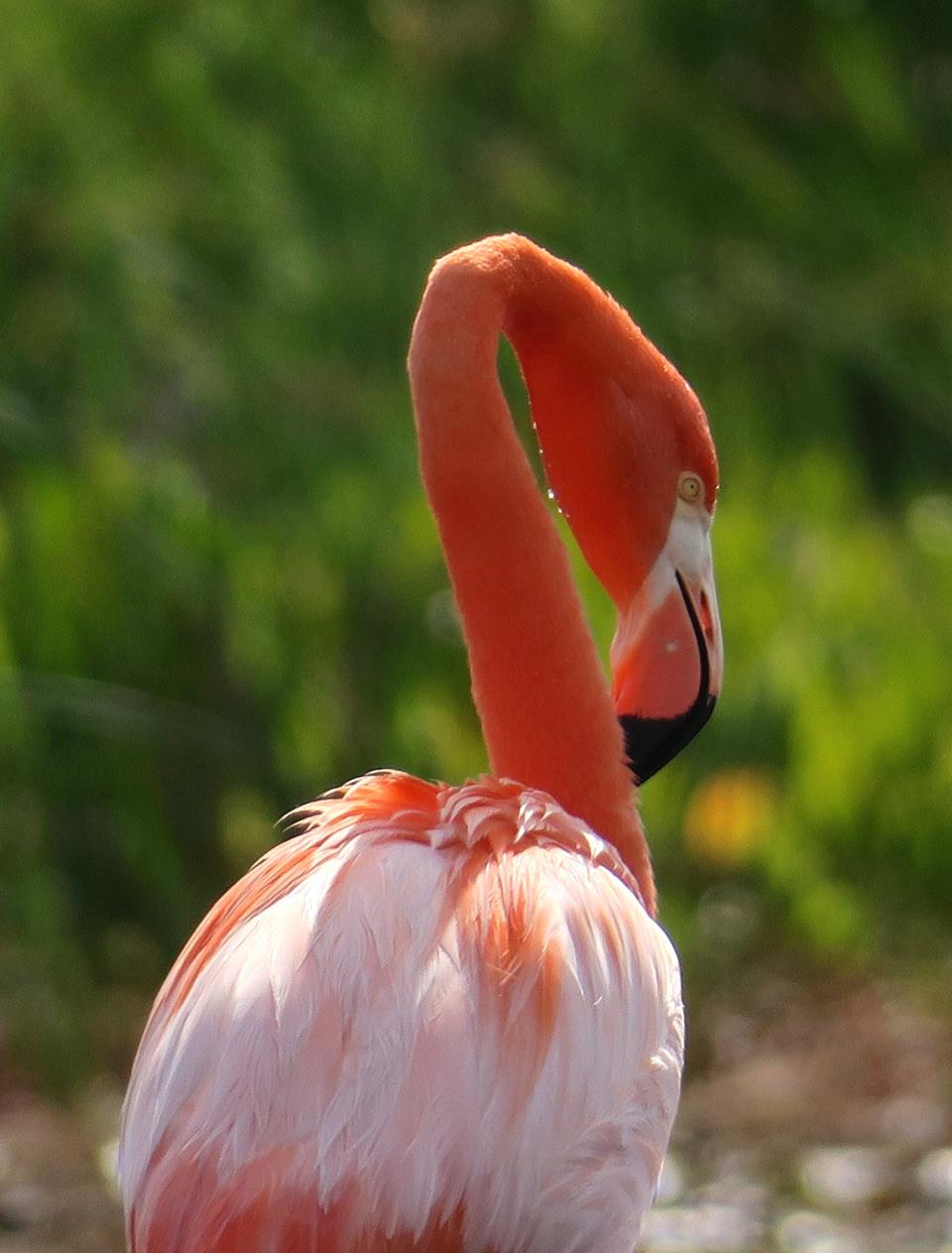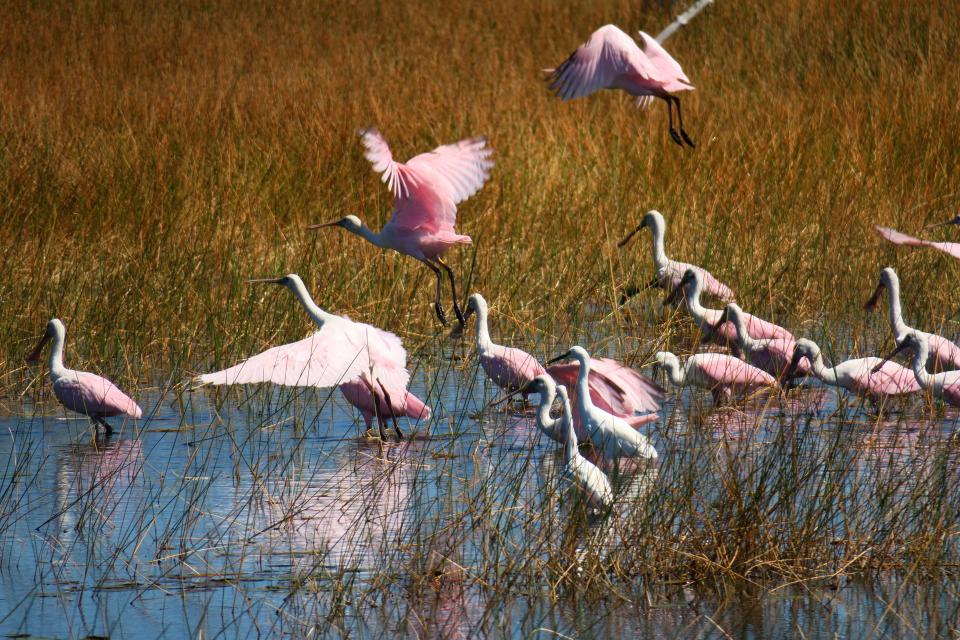Pinky, the St. Marks refuge's celebrity flamingo, has rock star appeal for birders
A lone flamingo blew into the St. Marks National Wildlife Refuge with Hurricane Michael in 2018, a refugee from the storm. It never left.
The flamingo earned a nickname — Pinky — and the most frequent question at the front gate and visitor center from visitors soon became “where’s Pinky today?” In reality, the bird is both neon orange and hot pink, but the name “Pinky” stuck and birdwatchers from throughout the United States seek to glimpse the rare visitor.

Nearly five years later, Pinky, the celebrity flamingo, is often spotted in open water bodies along Lighthouse Road and sometimes in the large pool across from the St. Marks Lighthouse, depending on water levels. If fortunate, Pinky is near the road or a dike trail, but sometimes she/he is far out in the middle of a pond and only a speck of its pink/orange color can be seen with the naked eye.
Good binoculars, a spotting scope, or a camera with a strong zoom lens are often required to view Pinky. Occasionally, Pinky will leave the refuge for a few days or weeks, only to faithfully return to the Lighthouse Road area.
A wild American flamingo
Pinky is known to be an American flamingo (also known as the Caribbean flamingo), one of six flamingo species worldwide.
One can often see Pinky in shallow water stamping its webbed feet to stir up food. Then, with its head slightly upside down beneath the water’s surface, it swishes its bill from side to side. Pinky is using its tongue to pump water in an out of its bill while comb-like plates along the bill’s edge filters out water and traps food inside.
Like other flamingos, Pinky is eating algae, small seeds, fly larvae and tiny crustaceans like brine shrimp. This food often contains colored pigments known as carotenoids, the reason tomatoes are red and carrots are orange, and so Pinky is metabolizing these pigments, giving its feathers their distinct pink and orange colors.

Pinky was the first wild flamingo recorded in the region since 1995 when Hurricane Allison blew in. Before that, a flamingo was spotted in 1972 soon after Hurricane Agnes. All of the storms skirted Mexico’s Yucatan Peninsula or Cuba, areas known for their abundance of wild flamingos.
Not a 'flamboyance'
It must be some kind of ride — flying with a hurricane! Thus far, we’ve only had one or two flamingos in our area at a time. Too bad. A group of flamingos is known as a “flamboyance.”
For a long time, flamingos were thought to be non-native Florida birds, usually seen only at roadside attractions and zoos since the gangly bird inexplicably became one of Florida’s iconic images alongside palm trees, oranges, alligators and bathing beauties.
But many ornithologists now maintain that flamingos were once native to extreme South Florida until wild populations were killed off by plume hunters in the late 1800s, so those plastic lawn ornaments are not off base after all! Most native American flamingo populations today are found in the Caribbean and Yucatan, although flamingos are starting to repopulate South Florida again. Most believe Pinky had been a wild bird since it bore no tag of any kind.

Birds of pink
It is easy to project human emotions onto Pinky — is he or she lonely? Is there a yearning to be with members of its own kind? Why doesn’t Pinky return to where he or she came from? Is Pinky disoriented?
Whether Pinky has such feelings is difficult to fathom, but Pinky does associate with other wading birds on occasion, especially the bright pink roseate spoonbills that are frequenting the refuge in larger numbers. Do birds of pink flock together?
How long Pinky will remain is anyone’s guess. Flamingos live 20 to 30 years on average with the oldest captive American flamingo living to be 67, so hopefully the question of “where’s Pinky” will linger for many more years at the St. Marks National Wildlife Refuge.
Dine with a view: 16 of our favorite waterfront restaurants around the Panhandle and Forgotten Coast

Doug Alderson is the author of numerous award-winning books about Florida, including "Discovering Florida’s Coast," "Florida’s Rivers," and "America’s Alligator." Learn more at dougalderson.net.
Send us your best flamingo shot
If you're one of the photographers stalking a great shot at photogenic St. Marks Refuge, consider sharing. Send your shots of the famous flamingo: email 2 or 3 high-resolution jpeg photos (3-10 MB) to news@tallahassee.com. Please include a sentence about when and where photo was taken. We'll gather the best and post a photo gallery to share with readers and publish some favorites in print in October around the 5-year anniversary of Hurricane Michael.
This article originally appeared on Tallahassee Democrat: St. Marks flamingo Pinky endures five years after Hurricane Michael

